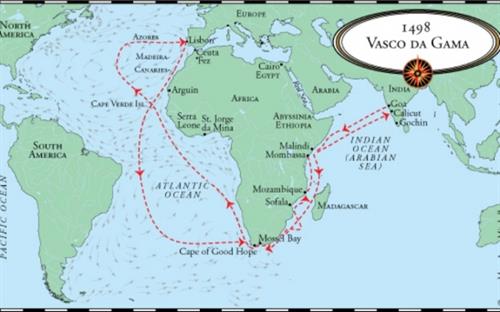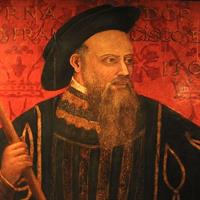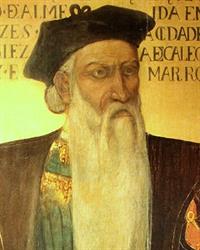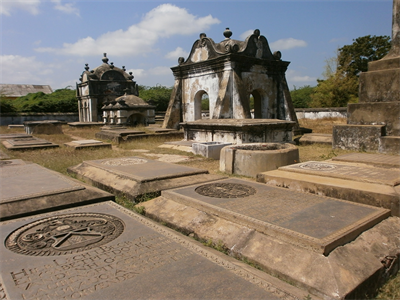PDF chapter test TRY NOW
The roadway between Europe and India was blocked by the Turks who conquered Constantinople in 1453AD. They also raided the Balkan Peninsula and North Africa. Thus the European were forced to find other possible routes to India, including sea transportation.
Portuguese
Portuguese was the pioneer one who searched the sea route to India among other European counterparts. “Henry” Prince of Portugal, famously known as the “Navigator” encouraged his fellow citizens to explore the unknown regions of the world, including India.
Bartholomew Diaz
Bartholomew is a Portugal sailor, reached the southern tip of the African continent in 1487. King John II funded him.
Vasco da Gama
Continuing Bartholomew Diaz, Vasco da Gama also reached the southern tip of Africa, and then Mozambique. From there with the guidance of an Indian sailor, he reached Calicut (A.D (CE) 1498) in India. The king of Calicut, “Zamorin” welcomed him.
Continuing Bartholomew Diaz, Vasco da Gama also reached the southern tip of Africa, and then Mozambique. From there with the guidance of an Indian sailor, he reached Calicut (A.D (CE) 1498) in India. The king of Calicut, “Zamorin” welcomed him.
After that, he came once again to Calicut in 1501 with 20 vessels and established a trade centre in Cannanore. One after the other, they set up manufacturing plants at Calicut and Cochin. After conquering the king of Calicut, eventually Cochin was their first capital in India.
Soon after reaching India during his third voyage, Vasco da Gama fell ill and died in December 1542, Cochin.


Pedro Álvares Cabral
Pedro Álvares Cabral was another Portuguese navigator who sailed to India after the first voyage of Vasco da Gama. In 1500, he came to India with 13 ships and a few hundred troops.
Francisco de Almeida (1505-1509)
In 1505, he was designated as the first Governor of Portuguese for India. His strategy towards India is also termed as the “Blue Water Policy”. He had focused on evolving the naval supremacy of the Portuguese in the Indian subcontinent.
The Arabs completely controlled trade over the Indian Ocean when the Portuguese wanted to break the monopoly. It indirectly spoiled the interest of Egypt and Turkey. Sultans of Bijapur and Gujarat were worried about the Portuguese's aggression on Ports located on the West Coast of India. So they made a coalition with Turkey and Egypt to fight against the Portuguese. Their combined naval force won a battle against the Portuguese near Chaul. Almeida's son lost his life in the battle. In 1509, there was a battle in Diu between the coalition fleet and the Portuguese fleet headed by Francisco de Almeida. Portuguese won the battle and claimed naval superpower in Asia.

Alfonso de Albuquerque (1509-1515)
The actual power of the Portuguese was established in India by Alfonso de Albuquerque. In November 1510, he captured Goa by conquering the sultan of Bijapur. He also established the Portuguese power over Ormuz in the Persian Gulf. To improve the relationship with India, Alfonso motivated the Portuguese to get married to Indian women. Good relationships were maintained between Vijayanagar Empire and the Portuguese during his leadership.

Nino de Cunha (1529-1538)
Nino de Cunha was a Governor of Portuguese possession in India.
In 1530, he shifted the capital from Cochin to Goa. In 1534, he captured Bassein from the monarch of Gujarat Bahadur Shah. After that, he captured Diu in 1537, Daman and Salsette in 1548.
In 1530, he shifted the capital from Cochin to Goa. In 1534, he captured Bassein from the monarch of Gujarat Bahadur Shah. After that, he captured Diu in 1537, Daman and Salsette in 1548.
Thus, the Portuguese vigorously expanded their territories during the 16th century. The Indian territories that fall under the Portuguese reign were as follows:
- West Coast: Goa, Daman, Diu, Salsette, Bassein, Chaul and Bombay
- East Coast: Hooghly on the Bengal coast and San Thome on the Madras coast.
In Goa, the Portuguese established a printing press ( in 1556), and a European scholar's research on an Indian herb was published in 1563. They are the ones who introduced tobacco farming in India. Catholic religion started to spread in India because of the Portuguese.
The 17th century witnessed the downfall of the Portuguese due to the Dutch aggression on Portuguese assets. In 1739 Portuguese territories were limited to Goa, Diu and Daman.
Dutch
After the Portuguese, the Dutch landed in India. Dutch created “United East India Company '' in 1602 to do business with India and the East Indies. In 1605, Dutch constructed their initial manufacturing plant in Masulipatnam (Andhra Pradesh). They showcased their dominance over India by capturing “Amboyna'' from the Portuguese. They also captured Nagapatnam and Pulicat near Chennai. Earlier, Pulicat was their headquarters, and later it was moved to Nagapatnam in 1690.
Silk, cotton, indigo, rice, and opium were the prime Indian goods dealt by the Dutch. The entire spice trade came under the control of the Dutch.
They constructed important manufacturing plants in the following cities: Pulicat, Surat, Chinsura, Kasim bazaar, Patna, Nagapatnam, Balasore and Cochin.
During the 17th century, there were unresolved disputes among the British East India Company, the Portuguese and the Dutch.
The dispute between the British and the Dutch further accelerated when they killed British merchants and some Javanese in Amboyna in 1623. The angry British troops conquered the Dutch in the Battle of Bedera in 1759, which terminated the Dutch penetration in India. After that, they lost their territories and assets one after the other to the British, and by 1795 they were entirely wiped out from India.
Dutch in Tamil Nadu
The Portuguese lost their control over Pulicat port in 1502 to the Dutch. The Dutch built their settlements and a fort named Geldria in 1610 and 1613, respectively, at Pulicat. They used the port to export diamonds to their fellow European Nations.

Geldria Fort (Pulicat)
The other architectural remnants of the Dutch era in Tamil Nadu are as follows: Nagapattinam, Punnakayal, Porto Novo, Cuddalore and Devanampatinam.
Reference:
https://im.indiatimes.in/content/2017/May/da-gama-royal-museums-greenwich-n_1495024122.jpg
https://im.indiatimes.in/media/content/2017/May/da_gaama_1495024410_725x725.jpg
https://alchetron.com/cdn/francisco-de-almeida-de012b38-d8ca-4124-ad14-835fbf4ac4c-resize-750.jpeg
https://www.onthisday.com/images/people/afonso-de-albuquerque-medium.jpg
https://en.wikipedia.org/wiki/Fort_Geldria
https://im.indiatimes.in/media/content/2017/May/da_gaama_1495024410_725x725.jpg
https://alchetron.com/cdn/francisco-de-almeida-de012b38-d8ca-4124-ad14-835fbf4ac4c-resize-750.jpeg
https://www.onthisday.com/images/people/afonso-de-albuquerque-medium.jpg
https://en.wikipedia.org/wiki/Fort_Geldria
